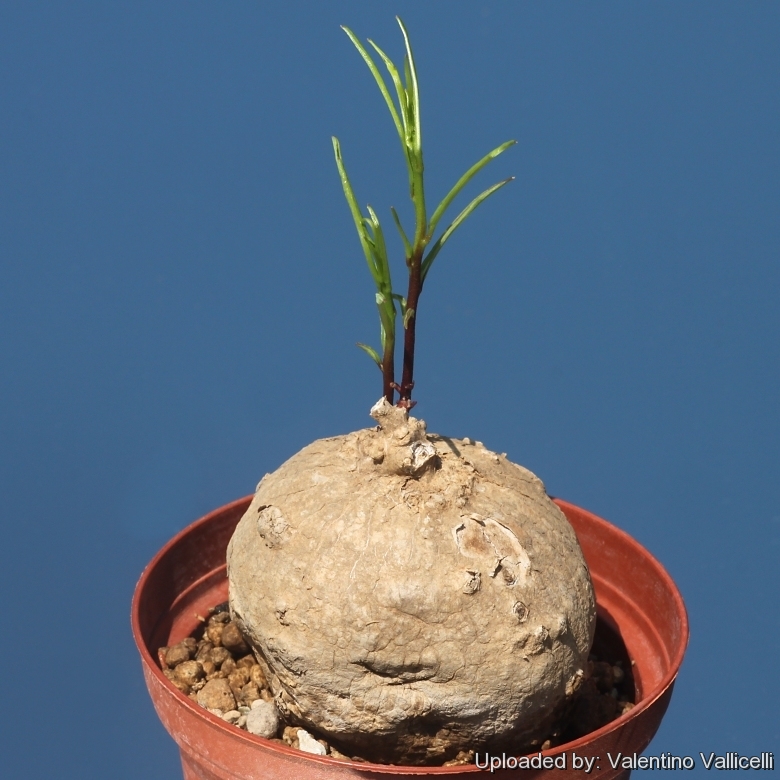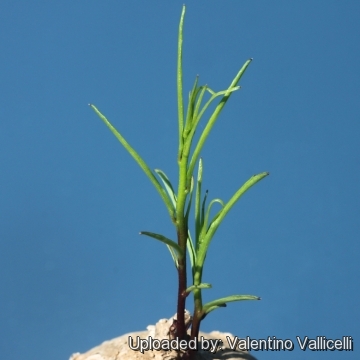
Ipomoea welwitschii Photo by: Valentino Vallicelli
Origin and Habitat: Angola; Namibia; Sudan; Tanzania; Zimbabwe; Zambia; Mozambique; Malawi; Botswana.
Altitude: 350–1650 m.
Habitat: Woodland, savanna, grassland on sandy soil.
Synonyms:
See all synonyms of Ipomoea welwitschii
back
Accepted name in llifle Database:Ipomoea welwitschii Vatke ex Hallier f.Bot. Jahrb. Syst. 18(1-2): 146. 1893 [22 Dec 1893]Synonymy: 7
back
Description: It is a perennial herb with a large woody tuber that produces new stems annually. The flowers are large and beautiful, with a trumpet-shaped tube. It is quite variable and related to Ipomoea simplex and Ipomoea bolusianaSN|1008]]SN|1008]], but usually hairy in some parts and with a different leaf shape. It also shows some resemblance to Ipomoea vernalis.
Tuber (rootstock): Perennial, globose, woody with a dark bark and edible, but often raised for aesthetic reason in cultivation.
Stems: Annual, herbaceous, up to 50 cm long, climbing upright to prostrate, robust, stiff, glabrous or finely hairy.
Leaves: Smooth or with short fine hairs on the nerves and margins, rigid erect, linear-lanceolate, ovate-lanceolate to oblong and often falcate, 4-12 cm long, 2-4 cm wide tappering at the apex, occasionally incised also bilobed or trisected with leaf segments less than 10 mm wide; petiole stout, 5–10 mm.
Inflorescences: Axillary, 1 to 3 flowered; peduncle up to 1 cm. long, stout, glabrous; bracts minute, lanceolate.
Flowers: Attractive, funnel-shaped, corolla white to pale pink with a pink or mauve throat some 5-9 cm long, spreading out into 5 fused petals with distinct darker midpetaline areas ofen ending in mucronate-aristate points; pedicels 1-2 cm long; sepals lance-shaped 10–14 mm long
Blooming season: Summer, it often flowers when the plant is almost leafless;
Fruit: Capsule globose.
Seeds: 4 mm long.
Notes: This species produces an unusual effect owing to the tuberous root being planted well out of the soil.
Bibliography: Flora Zambesiaca volume:8 part:1 (1987) Convolvulaceae by Maria Leonor Gonçalves
Flora of South Africa (2003) Author: Dr J.P. Roux
Flora of Tropical East Africa, page 1 (1963) Author: B. VERDCOURT (East African Herbarium)
 Ipomoea welwitschii Photo by: Valentino Vallicelli
Ipomoea welwitschii Photo by: Valentino VallicelliSend a photo of this plant.The gallery now contains thousands of pictures, however it is possible to do even more. We are, of course, seeking photos of species not yet shown in the gallery but not only that, we are also looking for better pictures than those already present.
Read More... Cultivation and Propagation: A very light and warm place in full sun is highly appreciated. It does best in a mineral soil, good drainage is essential. Water sparingly during the summer months and keep dry in winter. When not in growth it is killed right away, when given too much water. It is a slow growing long lived plant and once established, it will be content in its position and with its soil for years. It can tolerate moderate shade, and a plant that has been growing in shade should be slowly hardened off before placing it in full sun as the plant will be severely scorched if moved too suddenly from shade into sun.
Frost Tolerance: Tender, it needs frost protection.
Propagation: It is propagated from seed sown during spring or summer. Germination occurs within 3 weeks.











